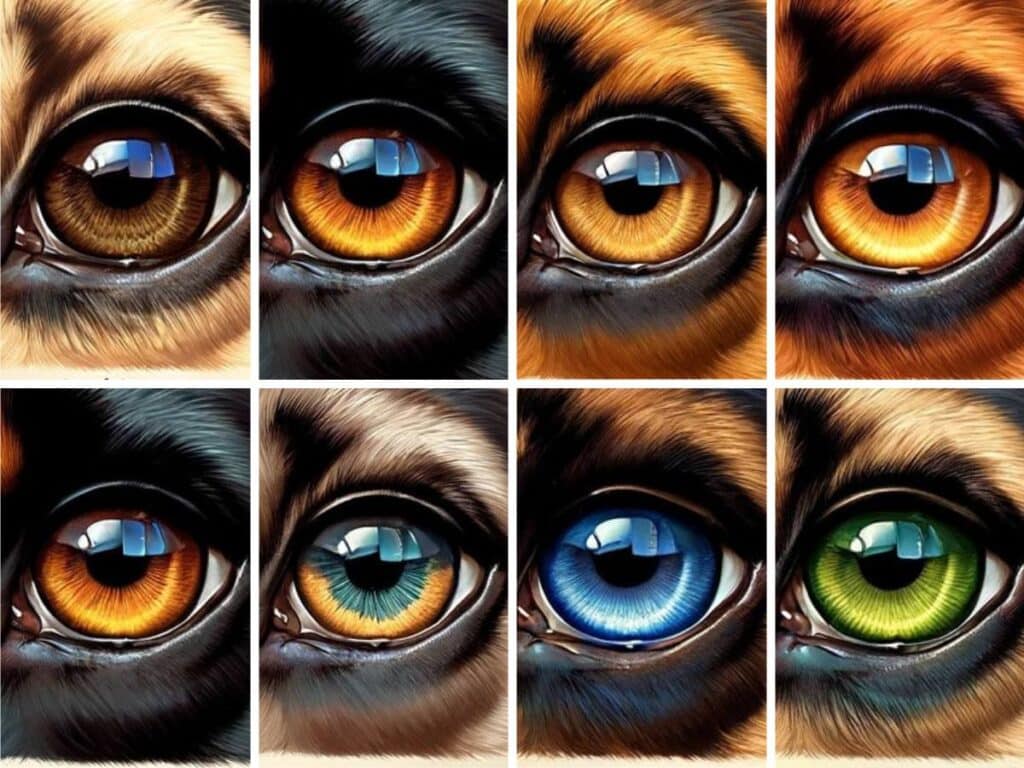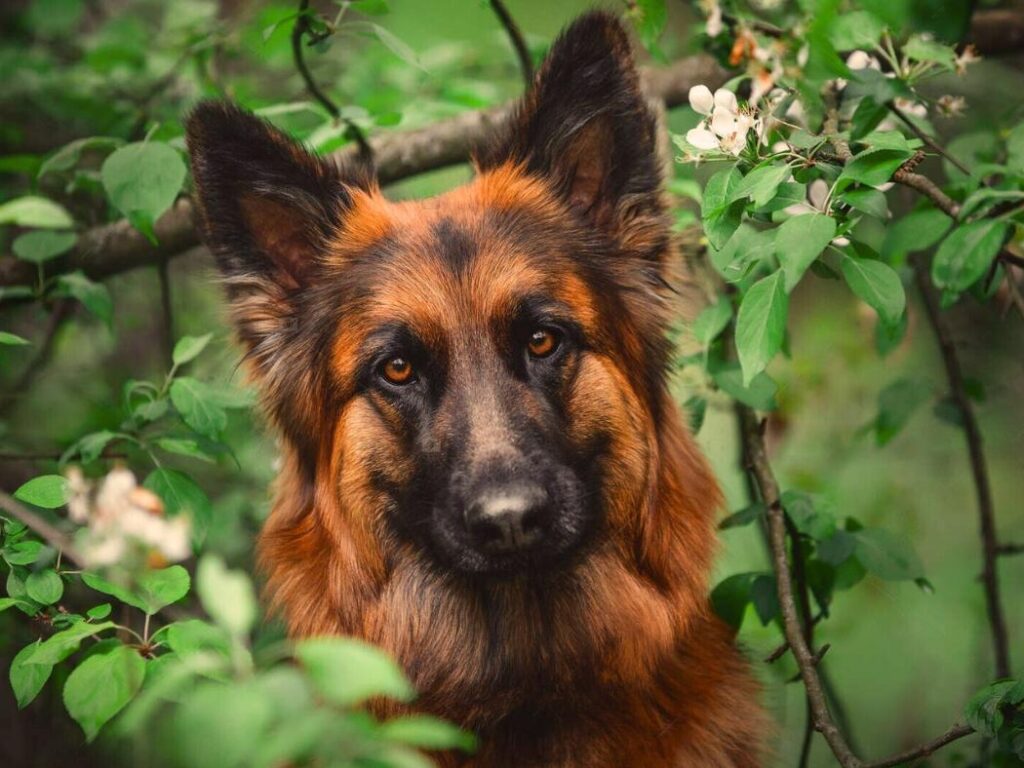The most common eye color for German Shepherds is various shades of brown, from a light amber to a deep, dark brown hue. However, some German Shepherds can also have green or blue eyes, a trait that is rare and often linked to specific genetic conditions or a lack of pigmentation.
These eye colors not only add to the aesthetic appeal of these dogs but also serve as a window to their genetic makeup.
This blog post delves into the fascinating world of German Shepherd eye color, exploring the genetics behind them, breed standards, and health implications.
Common German Shepherd Eye Colors
German Shepherds typically exhibit a range of eye colors that include yellow, amber, hazel, light brown, medium brown, and dark brown. Changes from puppyhood to adulthood are also noteworthy, as the eyes of a German Shepherd puppy can undergo significant color changes as they mature.
Here’s a closer look at the common eye colors found in German Shepherds:
- Dark Brown: The most common eye color, aligning with breed standards and giving a look of intensity.
- Medium Brown: A slightly lighter shade than dark brown, offering a softer expression while maintaining the breed’s characteristic gaze.
- Light Brown: A warm, honey-like color that captures the light. Common in puppies and may darken over time.
- Amber: A rare golden or coppery tint, creating a striking and unique look.
- Yellow: Extremely rare, offering a distinctive and noticeable appearance, especially in sunlight.
- Blue: Exceedingly rare and not recognized within the breed standard; linked to specific genetic factors and often associated with a lack of pigment.
- Hazel: Uncommon, presenting a mix of brown and green gives a vibrant and multi-dimensional look.
- Green: Probably the rarest instance, and it usually only appears in mixed-breed GSDs.
While eye color can be an interesting aspect of their appearance, it should not overshadow the importance of health, temperament, and overall well-being in these loyal companions.
German Shepherd Eye Color Chart
While most are familiar with the common dark brown eyes in German Shepherds, there’s a spectrum of colors that can appear, each adding to the uniqueness of the individual dog.
Here’s a comprehensive German Shepherd eye color chart detailing the eye colors you might encounter in German Shepherds, ranging from the more common brown to the rare blue & green.

| Eye Color | Description | Significance |
|---|---|---|
| Yellow | A light, vibrant hue, rare in purebreds. Typically seen in puppies and may darken with age. | Often considered a fault in show lines; does not affect health. |
| Amber | A golden, honey-like color, uncommon. | Not the standard but does not indicate health issues. |
| Hazel | A mix of green and brown, slightly more common than amber or yellow. | Accepted in most circles, not the breed standard but no health concerns. |
| Light Brown | A soft, light shade of brown, less common than medium or dark brown. | Normal and healthy, within standard expectations. |
| Medium Brown | The classic eye color, offering a deep, warm look. | The breed standard, associated with good genetics and health. |
| Dark Brown | A very deep, almost black color, intense and striking. | Reflects the breed standard, indicating a pure lineage. |
| Green | Extremely rare, giving a unique and mystical appearance. | Not standard; no health issues, but may indicate a mix if present in adults. |
| Blue | Captivating and unusual, often seen in puppies but usually changes as they mature. | Rare in adults and can indicate genetic concerns, but primarily an aesthetic variance without health implications. |
RELATED: Different German Shepherd Colors

Factors Influencing German Shepherd Eye Color
The eye color of German Shepherds, like many other traits in canines, is the result of a complex interplay of genetics and, to a lesser extent, environmental factors.
Genetic Factors and the Role of Melanin
At the heart of the German Shepherd’s eye color are genetics. Eye color in dogs is primarily determined by multiple genes that dictate the amount and distribution of melanin in the iris.
The most common eye color in German Shepherds is brown, which results from a high concentration of melanin. The darker the eye color, typically, the more melanin is present.
Cause of Rare Eye Colors in German Shepherds
Rare eye colors, such as blue or green, occur due to genetic variations that affect melanin production or distribution.
For instance, the gene mutation associated with blue eyes results in a reduction of melanin in the iris.
It’s important to note that these genetic factors are inherited, meaning that a puppy’s eye color is a direct result of the genetics passed down from its parents.
The Role of Environmental Factors
While genetics play the primary role in determining eye color, environmental factors can also have a minor influence.
For example, exposure to sunlight can slightly alter the perceived color of a dog’s eyes by affecting the iris’s melanin.
However, these changes are usually subtle and don’t result in a change from one distinct color to another, such as from brown to blue.
The Role of Breed Purity
Purebred German Shepherds are more likely to have the traditional brown eyes associated with the breed, due to the specific genetic pool that defines breed standards.
It’s also worth mentioning that certain breed lines within the German Shepherd breed may be more prone to specific eye colors due to selective breeding practices.
Heterochromia in German Shepherds
If you’re wondering “Can German Shepherds have 2 different colored eyes?” Well, the answer is Yes! In scientific terms, this phenomenon is called Heterochromia (two different colored eyes).
Heterochromia in German Shepherds is characterized by a difference in eye coloration, primarily in the iris of the eyes, resulting in each eye displaying a distinct color.

It can be attributed primarily to genetic variation or mutation. It can be inherited as a result of the combination of genes received from the parents (Genetic Heterochromia) or can occur as a spontaneous mutation (Acquired Heterochromia).
Types of Heterochromia
Heterochromia can be categorized into two main types, each presenting a unique visual appeal:
- Complete Heterochromia: In this type, one iris is a completely different color from the other. For example, a German Shepherd might have one blue eye and one brown eye.
- Sectoral Heterochromia: Also known as partial heterochromia, this occurs when a segment of one iris is a different color from the rest of the iris. This can result in a very distinctive and striking appearance.
It’s important to note that heterochromia is primarily a cosmetic difference without any inherent health implications.
Heterochromia does not typically affect a dog’s vision or ocular health. However, since it can be associated with other genetic factors or health conditions, a veterinary check-up is recommended to rule out any underlying issues.
Also, heterochromia in German Shepherds is not a standard breed trait and does not conform to the breed standards set by major kennel clubs.
Can a German Shepherd Have Blue Eyes?
While the traditional eye color for German Shepherds is brown, ranging from light to very dark, there are instances where a German Shepherd can indeed have blue eyes.

The Genetics Behind German Shepherd Blue Eyes
Blue eyes in German Shepherds, as in other breeds, are primarily the result of genetic factors affecting melanin distribution in the iris.
Melanin. as we already discussed, is the pigment responsible for coloration in the eyes, skin, and fur.
In the case of blue eyes, the gene mutation leads to a reduced melanin concentration in the iris, allowing light to scatter and reflect in such a way that the eyes appear blue.
How Rare is a German Shepherd With Blue Eyes?
Blue eyes are quite uncommon in German Shepherds, especially purebreds. When blue eyes do occur, it’s often in dogs that are not purebred or in those that carry genes from other breeds where blue eyes are more common.
Additionally, puppies may be born with blue eyes, but this color often changes as they mature, with the final eye color typically settling by the time they are a few months old.
In some cases, German Shepherds may have blue eyes as a result of genetic variations unrelated to the merle gene. These instances are exceptionally rare and can be considered anomalies within the breed.
RELATED: German Shepherd With Blue Eyes
Impact of Eye Color on Health in German Shepherds
The color of a German Shepherd’s eyes does not inherently affect its health or vision.
The primary health consideration related to eye color in dogs revolves around the genes responsible for certain colors, rather than the pigmentation of the iris itself.
For example, the merle gene, which can cause blue eyes in some dogs, is associated with a higher risk of sensory impairments, including deafness and vision problems.
However, it’s important to note that these risks are linked to the gene and not directly to the eye color.
Do German Shepherd’s Eyes Change Color Over Time?
Yes, German Shepherd eye color can change with time, particularly from puppyhood to adulthood.

Newborn German Shepherds typically have blue eyes, a common trait among many dog breeds.
However, as they grow and mature, the eye color usually changes, with the final adult color becoming apparent by the time they are around 3 to 4 months old.
This change occurs as melanin, the pigment that gives color to the eyes, increases in the iris.
For most German Shepherds, the adult eye color settles into various shades of brown, ranging from light amber to dark brown.
It’s important to note that significant changes in eye color beyond this maturation period are uncommon and, if observed, should prompt a veterinary consultation to rule out any potential health issues.
RELATED: German Shepherd Growth Chart
German Shepherd Puppy Eye Color
German Shepherd puppies are typically born with blue eyes, a trait common to many newborn dogs.

This striking eye color in puppies is due to the lack of melanin, the pigment responsible for coloring the iris, which has not yet fully developed.
As the puppies grow and age, melanin production increases, leading to a change in eye color.
By the time a German Shepherd puppy reaches 3 to 4 months old, you can expect their eye color to settle into its permanent shade.
For the majority of German Shepherds, this results in various shades of brown, from light amber to deep, dark brown, which remains consistent throughout their adult lives.
Common German Shepherd Eye Problems
German Shepherds are prone to several eye conditions that can affect their health and quality of life. Understanding these common eye problems, their signs, and basic management strategies can help you keep your GSD’s vision as healthy as possible.
1. Progressive Retinal Atrophy (PRA)
Progressive Retinal Atrophy (PRA) is a genetic condition characterized by the bilateral degeneration of the retina, leading to progressive vision loss and ultimately blindness.
While not exclusive to German Shepherds, they can be affected by this condition. Symptoms often start with night blindness, progressing to full vision loss as the disease advances.
2. Cataracts
Cataracts in German Shepherds involve the clouding of the lens, which can lead to impaired vision and potentially blindness if left untreated. Cataracts can develop due to aging, diabetes, injuries, or genetic predispositions.
3. Glaucoma
Glaucoma is a condition caused by increased pressure within the eye, leading to pain, redness, vision loss, and potential blindness. Early detection and treatment are vital to managing glaucoma and preserving vision.
4. Ectropion and Entropion
Ectropion is a condition where the eyelid rolls outward, exposing the eye to irritants and potential injury.
Entropion, conversely, involves the eyelid rolling inward, causing the eyelashes to rub against the cornea, leading to irritation and discomfort. Both conditions can affect German Shepherds.
5. Conjunctivitis
Conjunctivitis, or pink eye, is the inflammation of the conjunctiva and can be caused by allergies, infections, or foreign bodies in the eye. Symptoms include redness, swelling, discharge, and itching.
6. Pannus
Pannus, or Chronic Superficial Keratitis, is an autoimmune disease that primarily affects the cornea of German Shepherds, leading to inflammation, pigmentation, and potential vision loss.
The condition is characterized by the gradual appearance of a grayish-pink film over the cornea, which can progress to significantly impair vision if left untreated.
RELATED: Common German Shepherd Eye Problems
Summary
The exploration of German Shepherd eye color reveals the complexity and beauty of canine genetics. From the common deep browns to the rare and captivating blues and heterochromias, eye color in German Shepherds adds to the allure of this noble breed. However, it’s crucial to remember that the essence of a German Shepherd lies not in the color of their eyes but in their character, intelligence, and loyalty.
Frequently Asked Questions (FAQs)
1. Can German Shepherds have green eyes?
It is extremely rare and not standard for German Shepherds to have green eyes. The typical eye color for this breed ranges from light amber to dark brown.
2. Do German Shepherd puppies’ eyes change color?
Yes, German Shepherd puppies often have blue eyes at birth, which change to their permanent color, usually a shade of brown, by the time they are 3 to 4 months old.
3. Do German Shepherds have yellow eyes?
German Shepherds typically do not have yellow eyes. Their eye color spectrum ranges from light amber, which may appear yellowish, to deep brown, but pure yellow eyes are not common.
4. Can German Shepherds have different colored eyes?
While extremely rare, German Shepherds can have heterochromia, a condition where each eye is a different color, but this is not typical for the breed.
FURTHER READING:




